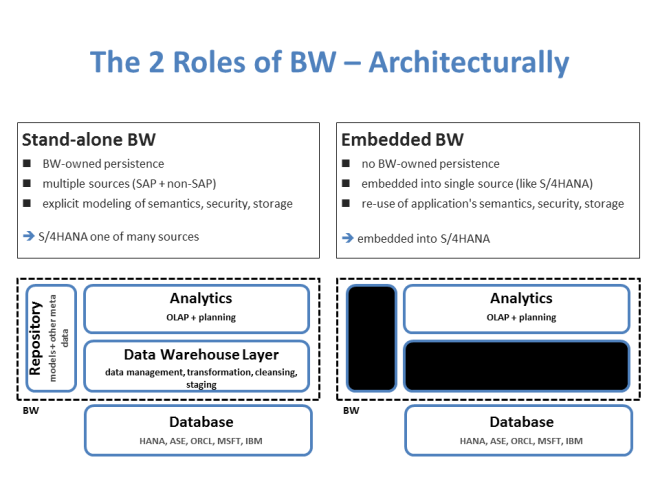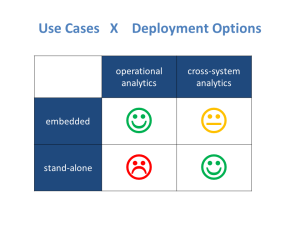- SAP Community
- Products and Technology
- Technology
- Technology Blogs by SAP
- S/4HANA and #BWonHANA
- Subscribe to RSS Feed
- Mark as New
- Mark as Read
- Bookmark
- Subscribe
- Printer Friendly Page
- Report Inappropriate Content
For many years, the absence of powerful analytic modeling and processing within SAP's R/3 and Business Suite applications led customers to install an instance of Business Warehouse (BW) next to such a system. Essentially, BW closed the analytic gap of those solutions. To that end, data was loaded from R/3 or the Business Suite into BW. Maintaining those load processes, two systems and the resulting time lag between the data being created in R/3 or Business Suite and the data being visible in BW reporting was the price for this workaround. Now, that operational analyticsis possible within S/4HANA, this workaround has become obsolete. This is sometimes mis-perceived as BW becoming obsolete. Let's have a look into the situation to understand what is dead and what is alive.
In my recent blog on S/4HANA and Data Warehousing, I've made the point that data warehouses - in general - are still necessary, even with the advent of operational analytics in S/4HANA. Here, I like to tackle the topic from BW's point of view. To that end it is important to understand that BW can be deployed in two ways; fig. 1 shows this visually:
- embedded: into any application that runs on NetWeaver like SAP CRM, SCM, HR, FIN etc, and
- stand-alone: as an enterprise data warehouse (EDW) that allows to harmonise data originating from various, disconnected systems so that it can be analysed in a consistent way. This allows to get an understanding across many disparate business processes that exist in an enterprise.

Figure 1: Deployment options for BW.
So in both deployment options, BW exists and can be used for operational or cross-system analytics. This leads to 4 potential situations, also depicted in fig. 2:
- Embedded, used for operational analytics
- BW reuses application's storage, semantics, security.
- No redundancy.
- Stand-alone, used for operational analytics
- Data, semantics, security is copied to BW as a workaround as no analytics options are available in the app.
- This is the case that should be replaced as it is sufficient but not necessary.
- It is not ideal but a workaround to fill a gap within the app.
- Embedded, used for cross-system analytics
- BW within NetWeaver (on which S/4HANA, SAP Business Suite, SAP CRM etc are built) is used as a DW.
- Technically this is possible.
- However, it is currently not recommended due to concerns around workload + governance around the system.
- Stand-alone, used for cross-system analytics
- BW as a stand-alone data warehouse.
- This is the most frequent deployment of BW.

Figure 2: Theoretical combinations of BW use cases and BW deployment options.
Case 2. is solved in S/4HANA by replacing it with case 1. - which is not a prominent but yet a fact. This frequently leads to the misunderstanding that "BW was obsolete" which should actually read that case 2. is mostly obsolete (in the context of S/4HANA) . Furthermore, case 4. continues to be a valid, as is any data warehouse approach that blends S/4HANA data with data from other systems for deeper insight into what is going on in the enterprise. The advent of IoTscenarios makes this even more imperative than before.
This blog has been cross-published here. You can follow me on Twitter via @tfxz.
PS: The figures can be found in this slidedeck.
PPS: There is an excellent real-world example for case 1. in the blog How Nucor Simplified Their BW Landscape By Using An Embedded BW, maybe with a certain overlap with case 3.
- SAP Managed Tags:
- BW (SAP Business Warehouse)
You must be a registered user to add a comment. If you've already registered, sign in. Otherwise, register and sign in.
-
ABAP CDS Views - CDC (Change Data Capture)
2 -
AI
1 -
Analyze Workload Data
1 -
BTP
1 -
Business and IT Integration
2 -
Business application stu
1 -
Business Technology Platform
1 -
Business Trends
1,661 -
Business Trends
88 -
CAP
1 -
cf
1 -
Cloud Foundry
1 -
Confluent
1 -
Customer COE Basics and Fundamentals
1 -
Customer COE Latest and Greatest
3 -
Customer Data Browser app
1 -
Data Analysis Tool
1 -
data migration
1 -
data transfer
1 -
Datasphere
2 -
Event Information
1,400 -
Event Information
65 -
Expert
1 -
Expert Insights
178 -
Expert Insights
280 -
General
1 -
Google cloud
1 -
Google Next'24
1 -
Kafka
1 -
Life at SAP
784 -
Life at SAP
11 -
Migrate your Data App
1 -
MTA
1 -
Network Performance Analysis
1 -
NodeJS
1 -
PDF
1 -
POC
1 -
Product Updates
4,577 -
Product Updates
330 -
Replication Flow
1 -
RisewithSAP
1 -
SAP BTP
1 -
SAP BTP Cloud Foundry
1 -
SAP Cloud ALM
1 -
SAP Cloud Application Programming Model
1 -
SAP Datasphere
2 -
SAP S4HANA Cloud
1 -
SAP S4HANA Migration Cockpit
1 -
Technology Updates
6,886 -
Technology Updates
408 -
Workload Fluctuations
1
- Deployment Error "ABAP language version is not supported for objecttype WAPA." in Technology Q&A
- Transcation codes in S4HANA in Technology Q&A
- Convert GL Account Hierarchies from Fiori to Cost element Groups in SAP S4HANA in Technology Q&A
- Empowering Retail Business with a Seamless Data Migration to SAP S/4HANA in Technology Blogs by Members
- S4HANA Cloud XSLT Processor in Technology Q&A
| Subject | Kudos |
|---|---|
|
|
|
|
|
|
|
|
|
|
|
|
|
|
|
|
|
|
|
| User | Count |
|---|---|
| 13 | |
| 10 | |
| 10 | |
| 9 | |
| 8 | |
| 7 | |
| 6 | |
| 5 | |
| 5 | |
| 5 |